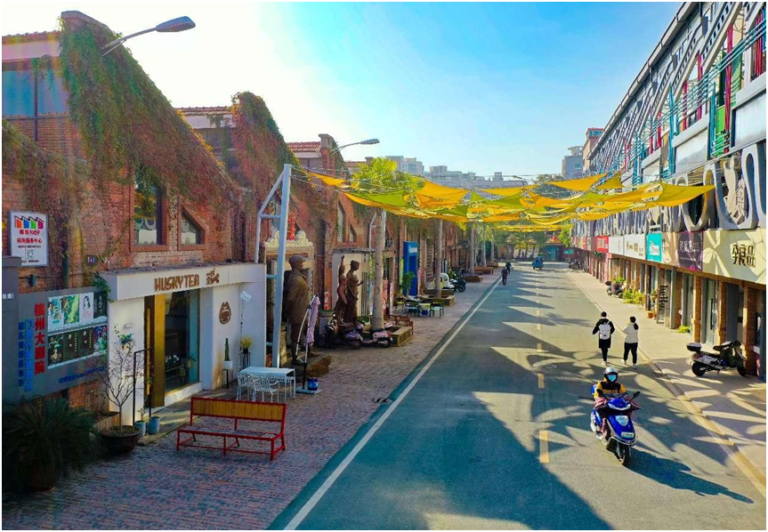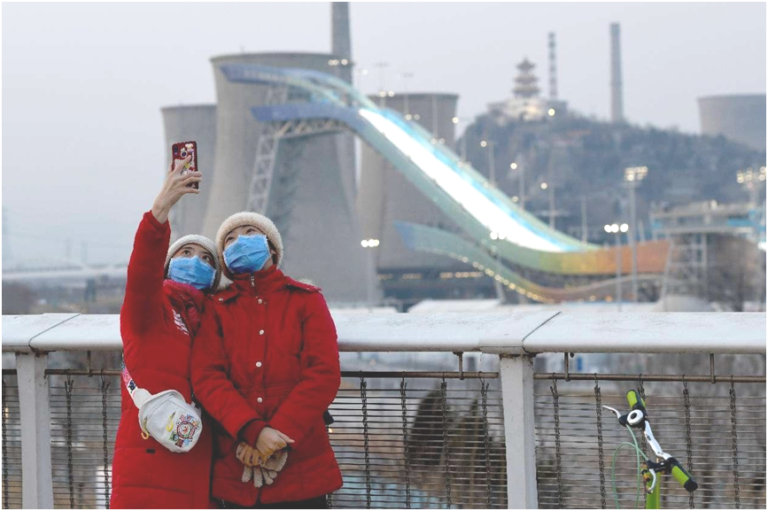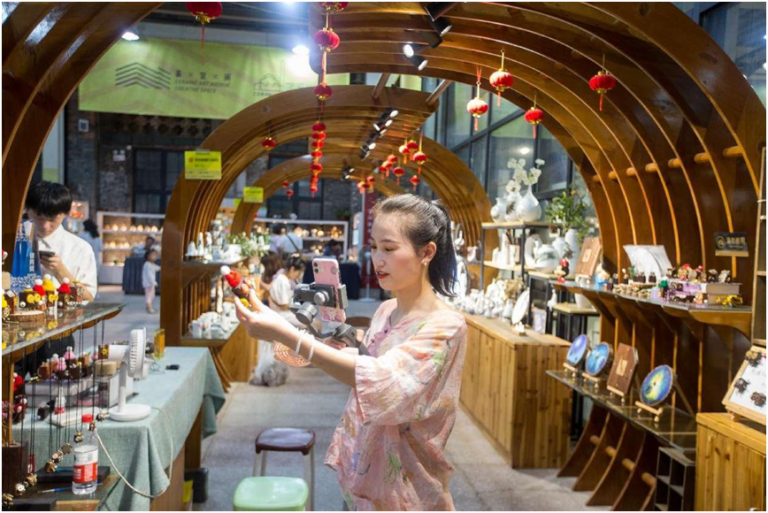
By Han Xin, People’s Daily
“Here come our new products. Check out this porcelain plate featuring freehand brushwork in traditional Chinese painting. It has rich and saturated colors and lifelike patterns of flowers,” said a maker named Zhou Xin during a livestreaming show on Chinese short-video platform Douyin.
“Ceramics are selling like hot cakes, which couldn’t have been possible without their cultural deposits,” said Zhou, whose new products weresold out shortly after they were released during the livestreaming show.
Zhou works atTaoxichuan Ceramic Art Revenue,aspecial cultural and creative zone transformed from industrial heritage at two former ceramic factories, in Jingdezhen city, east China’s Jiangxi province.
With well-designed ceramics experience space converted from old factory buildings and ingenious decorative artworks turned from disused facilities, Taoxichuan Ceramic Art Revenue offers a delightful contrast between the style of old factory buildings and modern designs.
The cultural and creative zone officially put into service in October 2016 is now a new cultural landmark and national cultural industry demonstration park in Jingdezhen city.

Based on industrial heritage at Taoxichuan Ceramic Art Revenue, a ceramic company in Jingdezhen city launched new ceramic cultural and creative brand, developed offline tourism products, and carried out online marketing, garnering more than 600 million yuan ($95 million) in annual operating revenue last year, according to Feng Jun, anexecutive with the company.
Industrial heritage sites, as an important vehicle of industrial culture, have witnessed different stages of China’s industrialization process. Recognizing the potential of industrial heritage sites for driving economic development, some Chinese cities have taken the lead in exploring various new ways of protecting while utilizing industrial heritage according to the characteristics and historical inheritance of different industrial heritage sites.
In addition to Taoxichuan Ceramic Art Revenue, more examples of successful transformation of industrial heritage sites have taken place in China in recent years, bringing exciting new looks to old factories, mines, and industrial areas.
Shougang Park, the former production premises of Chinese steelmaker Shougang Group in Shijingshan district of Beijing, has been turned into a cultural and sports complex where the rugged industrial look and dynamism of winter sports blend together perfectly.
The raw material area of the old plant has been transformed into the work site of the Beijing Organising Committee for the 2022 Olympic and Paralympic Winter Games, and a magnificent large ski-jumping platform namedBig Air Shougang has been built in the park to host competitions of Beijing 2022.
In Qingdao city, east China’s Shandong province, Tsingtao Brewery Co., Ltd., China’s major brewery and producer of Tsingtao Beer, built a beer museum inside a century-old former plant of the brand,which attractsmany tourists to the long history of the Tsingtao Beer as well as its technological processes.
In Yangpu district, east China’s Shanghai, an old warehouse has been transformed into an art gallery that enjoys great popularity on the Internet.

“Some old factory buildings and facilities, though rusty, can still be used for production. They are ‘living’ industrial heritage,” said Liu Boying, associate professor with the School of Architecture, Tsinghua University.
With efforts made to renovate, protect, transform, and reutilize such industrial heritage, it is shifting from single-purpose industrial site to integrated complex with various business forms satisfying people’s needs for production, leisure tourism, science popularization, and academic research, according to Liu.
Through the introduction of new functions, such as providing office space for companies as well as facilitating the development of culture-related industries and scientific and technological research, quite a lot of industrial heritage that can no longer perform its production functions is still able to embrace a new life. Such examples include electronic manufacturing plant-converted 798 Art Zone in Chaoyang district, Beijing and huge indoor exhibition hallstransformed from 80,000-ton silos in Minsheng Wharf, Shanghai.
Since 2017, China’s Ministry of Industry and Information Technology (MIIT) has announced 194 items on the country’s national industrial heritage list in five batches.
“In recent years, we have rescued a number of important industrial remains by releasing the national industrial heritage list, ”said an official with the MIIT, explaining that China protects and utilizes industrial heritage by transforming it into facilities including industrial tourism site, industrial park, urban complex, museum, open space, educational base, and film and television series making base.

“Efforts to turn industrial heritage sites into new space for cultural life that integrates memories of city, dissemination of knowledge, creative culture, as well as leisure experience can drive enterprises’ transformation, urban renewal, and regional economic development,” said the official.
In order to better protect and utilize industrial heritage, relevant authorities and enterprises need to carry out in-depth research into technological processes, find out and protect key parts of industrial heritage, promote industrial culture and improve economic value of industrial heritage while presenting a complete picture of production process, said Liu.
“According to incomplete statistics, there are nearly 1,000 industrial heritage sites in China. But the protection and utilization work is still in its initial stage,” said an official with the MIIT.
All sectors of society have reached broad consensus on strengthening the protection and utilization of industrial heritage, according to the official, who added that China is going to constantly improve public participation in relevant endeavors so as to continuously promote the creative transformation and development of industrial heritage.










